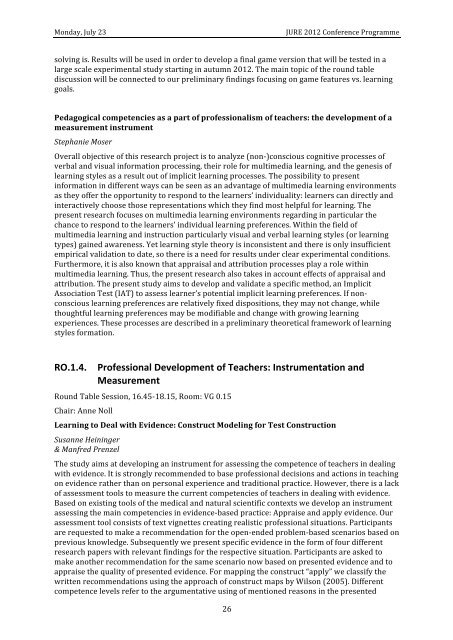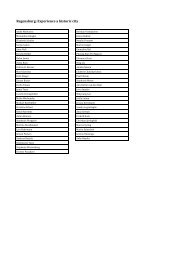JURE 2012 Programme book - EARLI Jure 2012
JURE 2012 Programme book - EARLI Jure 2012
JURE 2012 Programme book - EARLI Jure 2012
You also want an ePaper? Increase the reach of your titles
YUMPU automatically turns print PDFs into web optimized ePapers that Google loves.
Monday, July 23 <strong>JURE</strong> <strong>2012</strong> Conference <strong>Programme</strong><br />
solving is. Results will be used in order to develop a final game version that will be tested in a<br />
large scale experimental study starting in autumn <strong>2012</strong>. The main topic of the round table<br />
discussion will be connected to our preliminary findings focusing on game features vs. learning<br />
goals.<br />
Pedagogical competencies as a part of professionalism of teachers: the development of a<br />
measurement instrument<br />
Stephanie Moser<br />
Overall objective of this research project is to analyze (non-‐)conscious cognitive processes of<br />
verbal and visual information processing, their role for multimedia learning, and the genesis of<br />
learning styles as a result out of implicit learning processes. The possibility to present<br />
information in different ways can be seen as an advantage of multimedia learning environments<br />
as they offer the opportunity to respond to the learners’ individuality: learners can directly and<br />
interactively choose those representations which they find most helpful for learning. The<br />
present research focuses on multimedia learning environments regarding in particular the<br />
chance to respond to the learners’ individual learning preferences. Within the field of<br />
multimedia learning and instruction particularly visual and verbal learning styles (or learning<br />
types) gained awareness. Yet learning style theory is inconsistent and there is only insufficient<br />
empirical validation to date, so there is a need for results under clear experimental conditions.<br />
Furthermore, it is also known that appraisal and attribution processes play a role within<br />
multimedia learning. Thus, the present research also takes in account effects of appraisal and<br />
attribution. The present study aims to develop and validate a specific method, an Implicit<br />
Association Test (IAT) to assess learner’s potential implicit learning preferences. If non-‐<br />
conscious learning preferences are relatively fixed dispositions, they may not change, while<br />
thoughtful learning preferences may be modifiable and change with growing learning<br />
experiences. These processes are described in a preliminary theoretical framework of learning<br />
styles formation.<br />
RO.1.4. Professional Development of Teachers: Instrumentation and<br />
Measurement<br />
Round Table Session, 16.45-‐18.15, Room: VG 0.15<br />
Chair: Anne Noll<br />
Learning to Deal with Evidence: Construct Modeling for Test Construction<br />
Susanne Heininger<br />
& Manfred Prenzel<br />
The study aims at developing an instrument for assessing the competence of teachers in dealing<br />
with evidence. It is strongly recommended to base professional decisions and actions in teaching<br />
on evidence rather than on personal experience and traditional practice. However, there is a lack<br />
of assessment tools to measure the current competencies of teachers in dealing with evidence.<br />
Based on existing tools of the medical and natural scientific contexts we develop an instrument<br />
assessing the main competencies in evidence-‐based practice: Appraise and apply evidence. Our<br />
assessment tool consists of text vignettes creating realistic professional situations. Participants<br />
are requested to make a recommendation for the open-‐ended problem-‐based scenarios based on<br />
previous knowledge. Subsequently we present specific evidence in the form of four different<br />
research papers with relevant findings for the respective situation. Participants are asked to<br />
make another recommendation for the same scenario now based on presented evidence and to<br />
appraise the quality of presented evidence. For mapping the construct “apply” we classify the<br />
written recommendations using the approach of construct maps by Wilson (2005). Different<br />
competence levels refer to the argumentative using of mentioned reasons in the presented<br />
26



